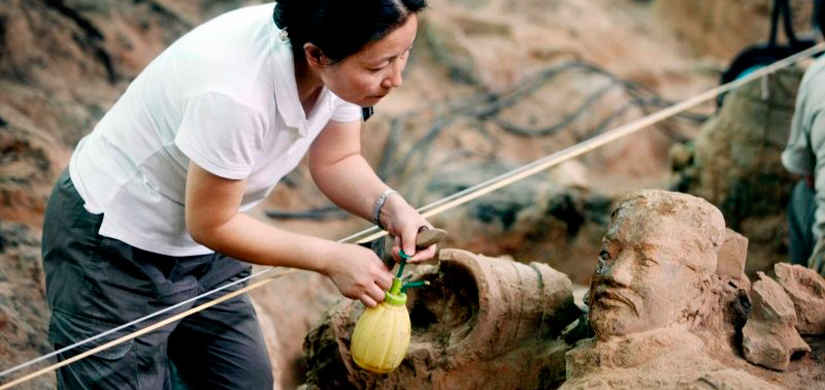You are in:
- Area of Communication and Media |
- Other News
Start of main content
Princess of Asturias Awards 05/19/2010
The archaeological team of the Warriors of Xi´an, 2010 Prince of Asturias Award Laureate for Social Sciences

The archaeological team of the Warriors of Xi´an. ©FPA
The Archaeological Team of the Terracotta Warriors and Horses in the Qin Shi Huang Mausoleum in Xi’an, 2010 Prince of Asturias Award Laureate for Social Sciences. The Jury for the Award announced its decision today in Oviedo.
Considered one of the most important archaeological discoveries of the 20th Century, the site of the terracotta warriors, also known as the warriors of Xi´an, is a rich source of information about the Chinese civilization.
The nomination was put forward by Carlos Blasco Villa, Ambassador of Spain in China.
The Terracotta Army is part of the mausoleum of Qinshihuang (221-207 B.C.), the first emperor to unify China and found the Qin Dynasty. It was discovered in 1974 and declared a World Heritage Site by UNESCO in 1987. Its discovery has had a major impact on research in sculpture, architecture, and Chinese society during this period of formation and consolidation of the empire.
This funeral complex, with all its grandeur, is one of the most important treasures of Chinese archaeology. Located near Xi’an, the ancient imperial capital of what is currently the province of Shaanxi, the army consists of over 7,000 life-size terracotta figures of warriors and horses, which were buried in military formation a short distance away from the tomb of the first emperor of the Qin dynasty.
The fortuitous discovery of a large statue led to the discovery of what is currently known as Pit 1. This space is a large subterranean rectangular chamber measuring 230 m, positioned from east to west, and 62 m wide, from north to south. It contains around 6,000 terracotta statues of warriors, chariots, and horses, arranged along 11 corridors measuring 3 x 200 m.
Two years later, in 1976, Pit 2 was discovered 20 m to the north of Pit 1. Smaller than the first pit, it houses around 1,400 statues, including horses and warriors, arranged in 14 rows and protected by kneeling archers. A short time later, the third pit was found, the smallest of the three, with 68 figures of officials, commanders and generals. While the busts and limbs were made with molds, the faces of the figures were shaped individually with different facial features. It is also possible to appreciate a wide variety of clothes and hairstyles in the figures, depending on the person they represent.
It is estimated that the construction of the mausoleum lasted approximately 38 years and required the work of hundreds of thousands of artisans and laborers. It opened to the public as a museum in 1979, and has received over 60 million visitors from around the world since then.
Recently, in 2007, architects found a 30 m high building buried over what could be the tomb of Qin Shihuang and situated under an artificial hill of earth measuring 51 m in height. The Shaanxi Archaeology Institute revealed that, using modern techniques, they had discovered a chamber with four walls and symmetrical stairs, although it has not yet been excavated. Scientists have also detected the existence of an advanced drainage system that would prevent water leaks from flooding the tomb.
The discoveries so far are very important, but there is still a lot of work to do, since it is one of the most outstanding archaeological findings in China and its excavation and conservation poses enormous technical difficulties. For all of this, the team in charge of carrying out these tasks has been awarded.
The Prince of Asturias Awards aim, to quote from the Statutes of the Foundation “to reward the scientific, technical, cultural, social and humanistic work performed by individuals, groups of individuals or institutions at international level.” Consonant with this spirit, the Prince of Asturias Award for Social Sciences “will be bestowed upon the person, institution, group of people or group of institutions whose work or research in the fields of Anthropology, Law, Economics, Geography, History, Psychology, Sociology and other Social Sciences constitutes a significant contribution to the progress of these sciences to the benefit of Mankind”.
This year a total of 23 candidatures from Algeria, Argentina, Brazil, Canada, China, Ecuador, France, Germany, India, Iran, Morocco, Norway, Peru, Poland, Thailand, United Kingdom, United States, and Spain ran for the Award.
This is the second of eight Prince of Asturias Awards to be bestowed this year for the thirtieth time. The Prince of Asturias Award for the Arts went to American sculptor Richard Serra. The rest of awards will be announced in the coming weeks in the following order: Communication and Humanities, Technical and Scientific Research, Letters and International Cooperation, with the Sports and Concord awards being announced in September.
Each Prince of Asturias Award, which date back to 1981, comprises a diploma, a Joan Miró sculpture representing and symbolising the Awards, an insignia bearing the Foundation's coat of arms, and a cash prize of 50,000 Euros. The awards will be presented in the autumn in Oviedo at a grand ceremony chaired by H.R.H. the Prince of Asturias.
End of main content
Sección de utilidades
Fin de la sección de utilidades
- Legal document Legal document (Access key 8)
- | Privacy policy Privacy policy (Access key )
- | Social networks ???en.portal.pie.menu107.title???
- | Cookies ???en.portal.pie.menu110.title???
- | Site map Site Map (Access key 3)
- | Contact Contact (Access key )
- | XHTML 1.0
- | CSS 2.1
- | WAI 'AA
© Copyright 2024. FUNDACIÓN PRINCESA DE ASTURIAS





